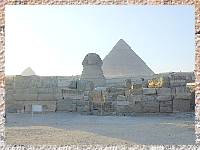|
Kheops’
successor, Djedefre, decided to move some 8 kilometres to
the north of Giza, to Abu Rawash, for his own burial. According
to some Egyptologists, Djedefre thus wanted to distance himself
from his father’s rule. Against this, however, it must
be noted that Kheops too choose to be buried at another cemetery
than his father, who in turn built his funerary monument at
a different location than his predecessor.
Djedefre
is not totally unattested in Giza, as he apparently did some
quarrying there. Some scholars have even proposed that it
was Djedefre, rather than his younger brother Khefren, who
has created the great Sphinx to the south-east of Kheops’
pyramid. In front of the Sphinx, a temple was built in its
honor.
 |
Khefren,
Djedefre’s successor and younger brother returned to
Giza where he built his pyramid to the south-west of Kheops’.
This pyramid is slightly smaller than its neighbour is, but
because it was built on a higher part of the Giza plateau,
it appears to rise higher. At its top, some of the limestone
blocks that originally encased the entire pyramid are still
present. To the south of the pyramid once stood a smaller
satellite pyramid, of which only traces remain today. Contrary
to most other royal pyramids of the 4th Dynasty
and later, Khefren’s is not accompanied at all by any
queen’s pyramids. A tomb built for Khamernebti, Khefren’s
wife, has been found at a small distance south of the great
Sphinx at Giza. Another wife of Khefren, Meresankh III, was
buried in a mastaba originally prepared for her mother, to
the east of Kheops’ pyramid.
The massif pillars and walls of the valley temple, which was
constructed right next to the great Sphinx, are well preserved.
None of the walls contains any decoration, but several statues
of the king, his head protected by the god of divine kingship,
Horus, were discovered in the 1860s during the excavation
of the valley temple. From the valley temple a causeway, of
which the original paving is still preserved, runs up the
plateau, to the remains of the mortuary temple.
Khefren’s
son and successor, Mykerinos, built the third and last pyramid
at Giza. Located to the south-west of Khefren’s, this
pyramid is significantly smaller than its two neighbours.
This has often been explained as a sign that the royal treasury
had been depleted by the megalomaniac building projects
of Kheops and Khefren, or as a sign that Mykerinos was a much
more benevolent king than his father and grandfather. It must
be noted, however, that most pyramids that were built after
Mykerinos’ reign, were all about the same size. The smaller
size of Mykerinos’ pyramid can thus more likely be explained
as a standardisation of pyramid building.
|
 |
Contrary to the two larger pyramids, Mykerinos’
had the palace-fašade motif carved on some of its interior
walls. This motif consists of some recessed panels and represents
the outer walls of a palace. The sarcophagus that once stood
in the burial chamber was lost at sea in 1838 during an attempt
to transport it to England.
Three
queens’ pyramids were built to the south of Mykerinos’
. The
mortuary temple was built against the east face of the main
pyramid. It was unfinished at the time Mykerinos died and
completed in mud-brick by Mykerinos’ successor, Shepseskaf.
Several statues, representing the king in the company of the
goddess Hathor and another deity, were found during excavation
works in this temple. These statues are on display in the
Egyptian Museum at Cairo. The mortuary temple was connected
to the valley temple in the east by a causeway.
Between
the valley temples of Mykerinos and Khefren, a tomb was built
for the enigmatic queen Khentkaus I. Her titulary can be translated
as "mother of two kings" or as "king, mother
of a king". In the latter case, she may have ruled Egypt
for some time herself. Shaped after a large sarcophagus, her
tomb is of the same type as Shepseskaf’s at Saqqara South.
This is an indication that Khentkaus I lived at the end of
the 4th Dynasty.
Whatever her role, she was apparently the last important member
of the royal family of the 4th dynasty to have
been buried at Giza. With Shepseskaf’s move back to Saqqara,
royal attention turned away from Giza. As much as we do not
know why Kheops choose Giza in the first places, we do not
know why it was abandoned as royal cemetery after Mykerinos
and Khentkaus I.
During
the New Kingdom some renewed interest was shown in the site.
Amenhotep II built a temple dedicated to the great Sphinx,
at that time believed to be the god Harmakhis. His son, Thutmosis
IV, erected a stela between the paws of the sphinx narrating
how he fell asleep in the desert after a hunt and how the
god Harmakhis had promised him kingship if he were to free
the sphinx from the sands.
The southernmost queen’s pyramid of Kheops was extended
to the east with a small temple dedicated to the goddess Isis
during the Late Dynastic Period. During the 26th
Dynasty, this temple was enlarged and the pyramid of Mykerinos
was restored. Several tombs were constructed next to the causeway
of Khefren’s mortuary complex, indicating that the site
had regained some of its religious importance. This would
continue to be used for private burials until the first Persian
domination.
(Jacques Kinnaer)
|